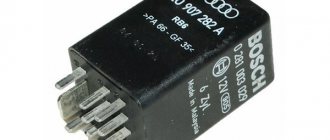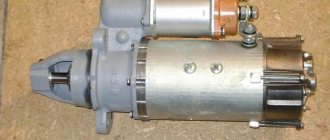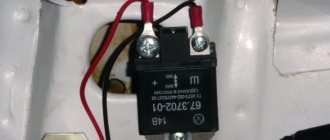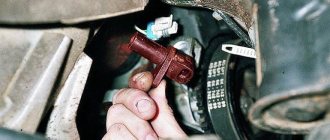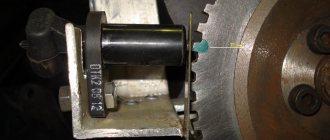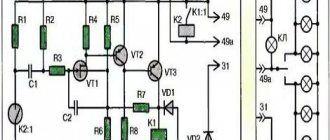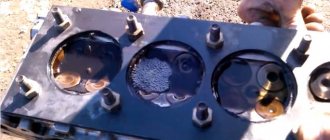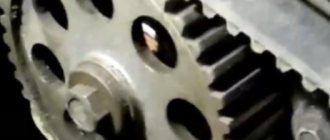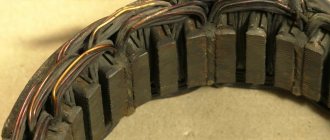Glow plug relay - checking its serviceability.
The glow plug relay is a fairly important part of any diesel car; if it fails, it will be very difficult to start the diesel engine in cold weather.
In this article we will look at what this relay is needed for, how it works and how to check its serviceability. If this relay fails, the glow plugs will stop working and heat the combustion chambers (pre-chambers) of the diesel engine and starting it in the cold season will be problematic. And the main question that should be clarified is why glow plugs do not work - what is the reason, in the glow plugs themselves, in their relay, or in the electrical wires, components with which it is connected.
And before you figure out how to check the operation of the glow plug relay, you should understand, at least roughly, how the glow plug system of a modern diesel engine works, which will be described below. This will help to quickly identify a malfunction, the culprit of which may be not only the spark plug relay, but also other components of the system.
It should be remembered that in addition to the glow plug relay, other components are also involved in the operation of the glow plugs, for example, the engine control unit, which calculates the operating time of the glow plugs (based on the temperature sensor readings), depending on the temperature of the antifreeze in the cooling system and, accordingly, the engine itself. The electronic engine control unit, on modern diesel engines, to determine the exact glow time of the spark plugs, reads information not only from the coolant temperature sensor, but also from the crankshaft sensor.
In addition, it should be taken into account that on modern diesel cars, a two-stage heating of the pre-chambers of a diesel engine is also used, which is gradually replacing the single-stage one. With two-stage heating, the glow plugs at the first stage (before starting the engine) heat the pre-chambers of each cylinder (or rather, its heads) and operate on a voltage of 12-11 volts (which drops when the plugs are heated to almost 9 volts). At the end of the first stage, the lamp on the instrument panel goes out, notifying the driver that it is time to start the engine.
Then, when the engine starts, the second stage occurs, in which the glow voltage drops to 7-5.5 volts, in which the spark plugs are not so hot (their temperature is lower), but they maintain stable operation of the diesel engine until it warms up to operating temperature .
In the second stage, when the engine runs with hot spark plugs, it not only runs more steadily, but the exhaust toxicity is significantly less. After the engine has warmed up and the coolant temperature has reached approximately 30° (warm-up time depends on the ambient temperature), the glow plugs are finally turned off.
As stated earlier, the relay operates from commands from the electronic control unit, and when voltage is applied to the relay control coil, it operates and turns on the glow plugs. But here, too, everything is not so simple, since after the relay is triggered, there is also a current-limiting resistor on the path of the current to the glow plugs, and after this resistor, the current reaches the glow plugs.
And another wire comes to this resistor, which connects it with the electronic control unit (more precisely, with the current sensor in this unit), and it is from the resistor that the ECU reads information about the normal operation of the glow plugs. And often many repairmen (after engine repairs) confuse or simply forget to connect the wire connecting the current-limiting resistor and the control unit, and the glow plug system stops working.
And many people think that the glow plug relay is faulty, but the problem is not that, but the incorrect connection (you can check it using the diagram, but it’s better to mark all the wires before repairing them, where they were).
System operation and glow plug relay check.
You can check the functionality of the system without starting the engine, using a multimeter (tester) set to voltmeter mode. We connect the tester probes (it is better to use alligator clips instead of probes) to the glow plugs (the positive probe to the spark plug tire, and the negative probe to the engine mass) and then turn the ignition key to the first position.
In this case, the click of the relay is clearly heard, and the tester should display the voltage that appears on the glow plugs. The value of this voltage is approximately 9 to 12 volts (it varies on different machines and the value depends on the type of spark plugs).
As I already said, there are single-stage systems (on older machines) and two-stage ones. With a single-stage system, everything is quite simple. After turning the ignition key to the first position, we will hear the glow plug relay click, and voltage will appear on the voltmeter and, accordingly, on the glow plugs (approximately 9-12 volts, depending on the type of plugs and the condition of the battery).
The spark plug indicator light will light up on the instrument panel. As the spark plugs heat up, after some time (the time depends on the temperature of the ambient air and the engine), a second click will occur, at which the lamp on the instrument panel will go out and the voltage on the spark plugs will disappear (and on the voltmeter, respectively). You can start the engine.
With a two-stage glow system, after the first click there should be a second, and after this second click, after approximately 4-5 seconds, the voltage on the spark plugs and on the voltmeter should decrease, since the current-limiting resistor comes into operation (the voltage on the spark plugs will go through this resistor).
When the engine starts and warms up to operating temperature, a signal from the temperature sensor will be sent to the electronic unit, which will give a command to the relay. In this case, a third click will occur, and the voltage will disappear on the voltmeter (and, accordingly, on the glow plugs). This is how a working glow plug system works, and if something is wrong, then you should look for the fault.
Measuring the voltage coming to the spark plugs is not an indicator of the normal operation of the spark plugs themselves. Therefore, before checking the relay and other components of the system, you should first check that the glow plugs are actually working and work without a relay, because glow plugs often fail (especially if they are not from a reputable manufacturer).
I described in detail how to check the normal operation of glow plugs in this article. It also describes several more reasons why a diesel engine stops starting when it gets cold.
And if the spark plugs do not work from the standard positive wire, then you should also check the spark plugs with separate wires (lighting wires are suitable), with the help of which voltage is supplied to the spark plugs directly from the battery. If, when connecting the wires from the battery, the spark plugs start working (at the same time, all the spark plugs glow to a bright crimson color within 4 - 5 seconds), then the problem is in the relay or in the wires (components).
The wire going to the relay should be checked for integrity, and although it is quite thick, designed for a current of about 60 - 80 amperes (and the relay too), it should still be checked from beginning to end. And the remaining wires coming to the relay and their terminals should also be checked (ringed) for integrity and, if necessary, their terminals should be cleaned if they are oxidized.
You should also check the 80-amp fuse, and if it is blown, then the light bulb (with a spiral) on the instrument panel will light up, but no voltage will flow to the spark plugs. Since the light on the panel indicates the normal operation of the control unit, and not the spark plugs themselves or the fuse. The fuse is easy to identify among others, since it is the most powerful of all the others.
How does it all work?
Ignition of the fuel-air mixture in the cylinders of a diesel engine occurs at temperatures of 800–850 °C. When the engine is warmed up, such indicators, at the moment of the compression stroke, are achieved instantly and the diesel engine starts without failure.
But when the car is not warmed up, it is difficult to achieve such a temperature only by compressing the mixture, especially in cold weather - starting the engine is problematic.
To solve this problem, glow plugs were installed in diesel engines, the task of which is to very quickly warm up the air in the cylinders to 75 degrees and thereby ensure the desired temperature at the moment of the compression stroke.
Inside the products, two spirals are structurally provided - heating and regulating.
The first one has a heating function. The second, due to floating electrical resistance, protects the glow plug from overheating.
The spark plugs will work until the coolant temperature goes above 60°C, this is about 3 minutes. Then the motor will be able to work without them.
Before starting the car, you must turn on the ignition and pay attention to the instrument panel. A glowing spiral indicator indicates that the glow plugs are heating up. As soon as the light goes out, you can start the car.
In modern cars, the spiral lamp may not light up. This will happen if the engine is already warmed up, which means there is no need for glow plugs. All this is achieved thanks to modern electronics that monitor the temperature indicators of the motor.
There are also glow plugs that maintain the temperature for a long time after warming up, and therefore turn off immediately after the starter is turned off and heat the air in the diesel cylinders due to residual heat.
The devices are very energy-consuming; heating one glow plug to 850-1350°C in half a minute can take an average of 8-16A (96-192 W), sometimes 40A. The amount of voltage and the time it is supplied are controlled by an electronic unit and a thermal relay (switch).
The latter, if necessary, only closes and opens the circuit, thereby setting the desired air temperature in the cylinders. And the ECU regulates the entire heating process by sending signals to the relay. It takes the necessary information from the crankshaft and coolant sensors.
The first sign indicating that one of the glow plugs has failed will be the re-ignition of the indicator in the form of a spiral after starting the engine and its prolonged burning (about 50 seconds).
If after the specified time, after warming up the car, the indicator does not go off, then the time relay (thermal switch) has failed. It is important to immediately replace the device, otherwise the glow plugs will fail due to the burnout of their heat pin.
If it is still relatively warm outside (above +5°C), then you are unlikely to notice the output of one or two products; the car will still start.
Otherwise, when the thermometer scale approaches zero and below, even with one faulty spark plug, starting the car when cold is problematic. This can only be done if it is heated to 60°C or more.
The glow plug relay is an important part in the operation of a car.
The glow plug relay is a very important part that is part of any diesel engine. If a real part of the vehicle fails, starting the engine will be quite problematic. Especially if it’s frosty outside and the humidity is high. This is due to the fact that the incandescent elements in this case also stop working, they do not heat the combustion chambers of the diesel engine and starting it becomes impossible.
This signal indicates a breakdown of the incandescent system
Let's take a closer look at what role the device plays, the principle of its operation and how to check the serviceability of the part.
see also
Comments 25
did you take the glow plug relay from an Audi of the 80s? It has 7 contacts, if you want the diagram I’ll send it to you in PM
I don’t understand why the candle is a torch. Are we talking about those glow plugs that are installed in each cylinder?
No, there’s one spark plug here, in front of the turbine.
Then I don't know. My Toyota diesel did not have a turbine))
I had an Estima diesel car with a 3speed engine. So that’s where the candles are glowing. The operating principle is as follows. When starting, the spark plugs burn for about 5 seconds. Then they go out. And when cranking the start, they light up again and stay on for 5 to a minute. It depends on how many are overboard. And they don't burn. I see I’ve already figured out the connection. Pay attention to the voltage at the spark plugs. Maybe it’s below 12. Then that’s why it burned. And if it’s not a secret, then why do you need it?
So I have a candle on Ivek, so I’m dealing with it.
Maybe the relay is stuck. I don't know the circuit diagram on your model. So it burned out
Sorry, the question is not clear, if this is a torch plug, then where is the fuel control valve, the torch heating turns on after -20 or even -25, or is it a glow plug just heating
Is this a question from a physics test at school?
By circuits, and knowledge of the contact numbers on the relay. Well, you can also make non-crossing wires in the diagram. Not any auto electrician will undertake such work. Although maybe a guy somewhere is trying to break the captcha. BGGGGGGGGgggggggggggggggggggg.
Like any other load, probably.
There are different types of candles! at 10 volts at 11 or 11.5 maybe there are other voltages. As I understand it in a diesel engine, it works through a special relay that gives heat for a certain time before starting to warm up the combustion chamber. They burn out because it must work for at least 20 seconds. and a maximum of 40 seconds. before starting the engine. Place the lamp directly parallel to the spark plug, but you will have to look for the relay! At a minimum, the way out is to simply power up the button via the relay and press it for 30 seconds before starting. I repeat - spark plugs are only needed for starting! Then they turn off! since they consume a lot of current, first the spark plugs turn on, then they turn off, and only then turn on the starter!
A lamp in the form of a spiral, or a regular 12V control?
and which one is better to put?
I just don’t know where it is, and what kind of spark plugs it is, on tractors, for example, the lamp was a spiral, and was switched on in series with the spark plugs, which provided both heating control and resistance for the spiral
and which one is better to put?
Yes, you can put an LED on it to indicate that there is power to the candle. Place it parallel to the candle and that’s it. Good luck!
look in the bulletin board, I installed an additional relay on the starter there, I think you can do the same)
Relay operating principle
The principle of operation of the glow plug relay is to control the voltage supplied to the glow plugs and the ability to regulate it. The device also controls the heating duration and temperature. The performance of the part directly depends on the readings of the crankshaft speed sensors and coolant temperature.
Modern diesel devices are designed in such a way that heating is carried out not only before starting, but also after the engine starts running. This allows you to reduce noise when the engine is running and significantly reduce harmful emissions into the atmosphere.
How does ignition occur in a diesel engine?
Brand tour
When choosing a glow plug relay, it makes sense to be guided not only by data on compatibility with the car, but also by who manufactured it. Today on the market you can find both budget analogues and first-class parts that are in no way inferior to the originals. We advise you to take the latter - they last a long time and work well, unlike the cheap “China” ones. And here's who produces the best relay:
- Beru (Germany);
- Vemo/Vaico (Germany);
- Jideco (Japan);
- Bosch (Germany);
- NGK (Japan).
Of course, there are budget solutions, and even two: used relays or relays from a low price category. Cheap does not always mean bad, but a cheap device always fails before a more expensive and high-quality one. To save on the purchase of a glow plug relay, you can buy spare parts from the following companies:
- Huco (Germany);
- ERA (Italy);
- Trucktec (Germany);
- Cargo (Denmark);
- Meyle (Germany).
Even if you find a cheap relay from a non-name manufacturer in the store, it is not worth buying. Often you have to wait weeks for delivery of such devices, but the wait in this case is justified - by taking a budget device, you are actually signing up to change the relay next winter.
Why check the performance of glow plugs and relays?
Glow plugs are located directly in the combustion chamber. They provide heating of the fuel so that ignition is as smooth and clear as possible. We can say that they are a pre-starting device for the engine. Their performance is especially important in winter. Due to a malfunction in the glow parts control unit, the driver simply will not be able to start the engine.
They are made from different materials. They may have a closed or open heating element. Their control circuit takes into account fuel temperature, air heating, and resistance changes. When the engine does not start, many drivers initially check this particular system.
There are many reasons why spark plugs can fail. This is the expiration date of the element, the weather conditions of the region in which the car is used. The cause of the problem may lie in electrical wires or other system components.
Checking the serviceability of the part
Many drivers know how to check the glow plug relay. To do this, you need to have a special device - a tester. The test begins by disconnecting it. Each driver can find out where the glow plug relay is located in the manual of his own car. Although it is quite easy to find it among other elements: it is significantly larger and more powerful than other parts. The tester is then connected to one terminal of the holder. A ground connection is also required. If there is no voltage, you should check whether it is coming from the battery.
System diagnostics begin with a “diagnosis” with a tester
Next, you need to connect the tester to the second terminal and ground. If there is no voltage, it is also important to check whether it is coming from the battery.
If there is voltage, it is necessary to check the serviceability of the high voltage wire. This wire is connected to the incandescent parts. If it is in working order, then the glow plug relay is not working and needs to be replaced.
By Mercedes car
The glow plug relay block on a Mercedes is located under the battery platform, just like in Opel cars. If this part fails, it must be replaced.
During the repair process, it is worth considering not only the manufacturer of the spare part, but also the type of spark plugs that are installed on the car. If they are ceramic, then the relay for metal spark plugs will not function.
Of course, you can also repair spare parts yourself, for example, replace burnt wires with new ones. Or install another switch. But these manipulations can only aggravate the situation and lead to serious problems with the car’s electrical system.
This is interesting: Why know the weight of a car battery?
Replacing an element
When the test shows that the device is not functioning, it needs to be replaced. Even a less experienced car enthusiast can do this. To do this, you will have to disconnect all the terminals from the part and take it out. Then it is important to clean the place where the device was removed. Then you need to carefully unscrew all the spark plugs. Next, carry out the entire process in reverse order, only with a new block: screw the glow parts into the new block, install it in a previously cleaned place.
The location of the candles is shown by red arrows
After this, you should try to start the engine. If this does not work, then you need to check whether all terminals are connected. If everything is installed correctly, but the engine still does not start, then the problem was probably not in the glow elements.
It is important to note that different vehicles may require different types and models of glow elements.
Owners of cars running on diesel fuel should prepare in advance for the cold season and check the functionality of the relay. It is also worth keeping control over the candles themselves. It is especially important to check the performance before a long journey. Otherwise, the trip may be disrupted and postponed until the problem is resolved.
Checking with a multimeter (tester)
The tester for checking diesel glow plugs is used in three modes:
- Measurement of resistance readings;
- Dialing method (if supported);
- Measurement of current consumption readings.
All methods can be applied without removing the product from the engine. But in this way we will only answer the question - “is the spark plug working or not.” It will not be possible to find out what condition it is in and the reasons for its breakdown.
Chain ringing
To check using the dialing method you need to:
- Disconnect the supply wire from the glow plug;
- Set the regulator on the tester to the desired position;
- Press the negative probe to the engine block, the positive probe to the electrode.
- The presence of sound indicates that the spiral is intact.
If you are using an analog tester, then you need to follow the arrow; its deviation indicates the integrity of the circuit.
This can also be done on a removed spark plug, only instead of a block, the probe must be attached to the body of the product.
The first and third methods are more informative, but they have their own characteristics that are important to know
Resistance measurement
Here it is important to understand the principle of the relationship between the ECU unit and the resistance of the spiral, which in a new glow plug should be in the range of 0.7-1.8 Ohms. The ECU is guided by the current consumed by the heating elements (A), which changes depending on their warming up
The amount of current is inversely proportional to the amount of resistance
The ECU focuses on the current consumed by the heating elements (A), which changes depending on their warming up. The amount of current is inversely proportional to the amount of resistance.
Those. Glow plugs are turned off when their resistance increases as a result of heating, and the current passing through the coil decreases. When a certain current value is reached, the ECU receives a signal that the spark plugs are warm and need to be turned off.
If the resistance, as a result of a malfunction of the heating elements, is too high (more than rated), then the current strength decreases earlier than necessary.
At this moment, the ECU receives a signal (premature in our case) that the glow plugs are warmed up and need to be turned off, which is what happens. At the same time, the air temperature in the cylinders remains insufficient for reliable engine starting.
Current consumption measurement
The most informative method, which involves starting a still cold engine. Those. There is no need to remove the glow plugs.
By measuring current consumption, you can quickly identify a faulty heating element. In this case, the reliability of the result obtained will approach 100%.
But here it is important to understand what types of glow plugs are installed in the engine and what their standard current consumption is. For example, if we take rod products, they can be single-pole and double-pole
For example, if we take rod products, they can be single-pole or double-pole.
The first ones are connected according to the classical scheme - ground on the body, one terminal coming off. Consume from 5 to 18 A.
The latter are determined by the presence of two terminals and can consume up to 50A.
To measure the current consumption, it is necessary to connect the tester in series in the “ammeter” mode into the electrical circuit that supplies the glow plug.
For this:
- Disconnect the power cable from the product;
- We switch the multimeter to ammeter mode;
- We connect one probe to the power wire, the second to the central terminal of the glow plug.
- An assistant will be needed. We start the car (the engine must be cold) and take readings from the device.
In the first seconds, the resistance on the electrode will be minimal, since the engine is still cold, and accordingly the tester will show the maximum current.
As the spark plug warms up, its resistance will increase and the current will drop. This will be displayed on the device. The reduction should take place without sudden changes, gradually. And then, at some stage, the current must stabilize.
It is better to write down the results of checking each spark plug so that they can be compared later. They should be as identical as possible.
If the behavior of a certain glow plug differs from others, then most likely only its middle or tip warms up. The absence of current will indicate an open circuit.
Here you will have to unscrew the product and recheck it, but visually observing the heating process. Typically this is already done using a directly connected battery (see below).
Diagnostics and replacement of glow plug relays
Perhaps all owners of diesel cars are well acquainted with glow plugs. These small “helpers” ensure reliable engine starting, especially in subzero temperatures. However, for their proper operation, it is necessary to monitor the condition of the glow plug relays. Let's try to figure out what it is, as well as how to check and replace the relay.
What is a glow plug relay?
Before you find out what a relay is, you need to understand the principle of operation of engine glow plugs. Everyone knows that in gasoline engines, a special device is used to ignite the working mixture - a spark plug, which creates a spark charge at certain points in time. There is no such device in diesel engines, since the mixture is ignited spontaneously directly at the compression stage. However, to make this process uninterrupted, it is necessary to first heat the mixture to the required state. For this purpose, glow plugs of a diesel engine are used. A current of a certain magnitude is supplied to the contacts of the spark plugs, with the help of which the coil is heated. The heat generated from the spiral side is directed to the intake manifold and cylinders, ensuring the mixture is heated to the required temperature.
In the process of increasing the engine temperature, the temperature of the mixture increases, the extra degrees for which is the ignition of the mixture even before it enters the engine cylinder, which leads to inefficient operation of the engine or even failure. To prevent this from happening, glow plugs change their temperature, maintaining it within certain limits. This is exactly what the glow plug relay is designed for.
A relay is a device that closes or opens an electrical circuit depending on changes in the controlled quantity. In this case, the relay temporarily supplies current to the glow plugs and cuts it off, allowing the plugs to “cool down”. After this, the cycle is repeated again until the motor stops.
It is quite logical that if this relay malfunctions, the glow plugs will also stop working. This means that the fuel will not receive the required temperature and will not burn efficiently, which will lead to loss of power and excessive fuel consumption. Therefore, this device must be maintained in working condition. Let's assume that we doubt its performance and we need to check it. It's time to find out how to do this.
What is it for
It's no secret that today the most common internal combustion engines run either gasoline or diesel. Gas-cylinder installations are gradually gaining popularity, but since they are not the topic of our discussion, we will leave them for later. So, the main executive component of the car ignition system is presented today:
- Glow plug in diesel engines;
- The spark plug, respectively, in gasoline engines.
The principle of operation of a spark plug can only be described as “the formation of a spark at a strictly defined point in time.” The spark plugs of diesel engines are not so strictly tied to time - the fuel, when compressed, begins to ignite spontaneously. However, another problem arises: spontaneous combustion does not always occur when it is needed. This is where glow plugs are needed. They heat the fuel mixture to the optimal temperature for engine operation and make its further combustion process stable and predictable. However, another problem appeared!
As a diesel engine operates, its individual components become very hot. Increasing temperatures also have a detrimental effect on the fuel. There are often cases when it begins to burn even before it gets into the cylinder, where the heat of combustion will be used to perform work. The weak link is the glow plugs - if they heat up too much, they destabilize the operation of the entire engine. To solve this problem, engineers introduced special relays.
A relay is an electrical device that can close or open a circuit in the event of a change in some controlled quantity . With the glow plug relay, everything is very simple: when the glow plug needs to work, it allows the action of current, but when the spark plug needs to “cool down,” the relay opens the circuit. This chain will be looped until the driver turns off the engine.
Where is the glow plug relay located, how to check and change it?
Since this relay is an electrical device, the process of checking it is significantly simplified. For this you will need a multimeter. First you need to find this relay. It can be made in the form of a separate block or box that is attached to the car body. The attachment point to the body is called the “ground”.
Through this connection, power is supplied from the negative terminal. All other ends are positive. The relay receives additional information on special terminals from the engine control unit. The block processes information from temperature sensors and creates the necessary impulse at the relay input, which causes it to close and open. This indicates that an additional set of wires is connected to the relay.
The easiest way to find this relay is by the wires coming out of the spark plugs. Next, switch the multimeter to measure voltage and measure it with the ignition on at the relay output. To do this, one of the probes is pressed against the terminals leading to the glow plugs, and the other to the car body. The output voltage must be at least 12 volts. As a last resort, measure the voltage at the battery terminals, and if it turns out to be 12 or more, and 11 at the relay, then it is considered faulty. Another way to check is to measure the resistance between the relay terminals. This is done individually for each type of device, since standard resistance values may vary.
There is another - indirect way of verification. To do this, unscrew the spark plugs, connect the wires with the relay to them and turn on the ignition. If the spark plugs start to heat up, then the relay is considered to be working. Otherwise, either the spark plugs or the relay itself are faulty.
To change the relay, you must first remove the wires from it leading from the electronic control unit and to the glow plugs. Then its fastening is unscrewed. After this, the ground connection point of the new relay with the body is thoroughly cleaned, and a new device is installed in place of the old one.
Before removing the plugs, you must remember their installation location, otherwise there is a risk of assembling the device incorrectly, which can ruin the operation of both the relay and the glow plugs. To avoid having to go under the hood again, it is also recommended to replace the spark plugs.
This completes the check and replacement of the glow plug relay. As you can see, this is not a complicated procedure and can be done on your own. We wish you good luck on the roads!
Test methods (diagnostics)
Many diesel car owners will say that the weak link in their car is the glow plugs. And this is not far from the truth.
These products really often fail, and the breakdown could have occurred in the summer, but it would appear in the winter, when the car stopped starting in cold weather.
Before diagnosing a malfunction, it is important to understand the principle by which diesel heating works in your car.
At the moment there are two of them:
- Turning on the glow plugs every time you start the engine is typical for older diesel engines.
- Periodic activation of heating elements depending on the temperature of the engine and the air supplied to the system.
It is also important to understand what types of glow plugs are installed, rod or ceramic.
If your car meets environmental standards up to Euro 4, then most likely the diesel engine has rod heating elements. If Euro 5, 6 - ceramic.
The latter have many additional features, the main ones:
- Intermediate glow function, with which the DPF particulate filter is regenerated.
- Pre- and post-start heating – ensures that the fuel burns out in a cold engine.
To check glow plugs, for example, on Renault Megane 2 station wagon 1.5 86 hp, Ford Mondeo 2 1.8 90 hp, Ford Transit 2.2, Renault Laguna 3 or other cars with diesel engines, you can use several methods. Moreover, the approach to checking will be the same regardless of whether they are removed from the engine or standing still.
Verification methods:
- BY VISUAL INSPECTION. The integrity and condition of the relay and wiring are checked, and after removal, the product itself is checked;
- USING A TESTER (MULTIMETER). The winding resistance or its breakage is checked.
- SPARKING. It is not used on new diesel engines with an ECU, since the latter may fail.
- USING A 12V BULB. A simple way to check for a broken spiral.
For quick diagnostics, provided you have access to the glow plugs and a multimeter, you can measure their resistance. You need to check it when it is cold. The advantage is the presence of a non-contact ammeter (induction type). Indicators should vary from 0.6 to 4.0 Ohms. A new spark plug may have 0.7-1.8 ohms.
If your tester does not show such a low resistance, then you can check for a break in the spiral - readings to infinity (1) will indicate this.
Also, many multimeters support the sound signal function when the wiring is ringing - there is a sound, which means the spiral is intact.
Despite the results obtained, an external inspection of the spark plugs is recommended, especially if the car’s mileage has exceeded 50 thousand km. The presence of tip deformation, melting, and soot deposits are unacceptable.
If the results of preliminary diagnostics are disastrous for all glow plugs at once, then most likely, a complete diagnostic of the electrical equipment included in the heating system will be required, since the simultaneous failure of all products indicates a global malfunction.
To check glow plugs on a diesel engine, in addition to visual inspection, you must use all the methods described below.
Each of them will require the presence of certain instruments and knowledge in electrics, but if you repair electrical wiring yourself at home at a household level, you will figure it out here too.
Volkswagen Transporter T3 › Logbook › Glow plug relay. Wiring
The last thing you need to do when removing the instrument panel is to bring the electrical wiring to life. As they say, electrical engineering is the science of contacts. We clean all the detachable connections as much as possible, simply throw away the extra collective farm parts and be surprised that something starts to work.
We thoroughly clean the crowns with negative wires. We collect the wires into bundles with cable ties.
We must solder all twists and cover them with an adhesive-based thermal tube, so the conductors will be isolated from oxygen and will not oxidize.
